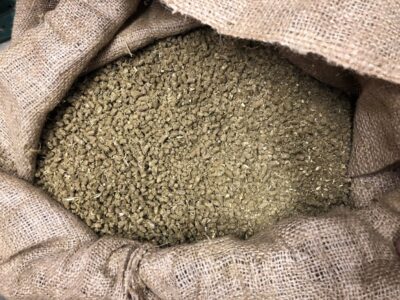One major challenge of harvesting cannabis or hemp is the post-harvest spoilage that may affect the quality and quantity of your hemp biomass. This is a major reason why farmers and CBD formulators should choose the right storage techniques — essential for maintaining a profitable business.
Related Post: Hemp Farming Guide: Planning Your Hemp Crop Rotation
Adopting the right storage method for dry hemp is arguably as important as planting, harvesting, or any other step involved in the cultivation of hemp. In this article, we’ll take a look at the things you need to be mindful of when storing hemp biomass safely.
How to Store Hemp Biomass or Dry Hemp
In conventional farming, the term “biomass” describes plant waste left behind after harvesting the useful part of the plants. This is not the case with hemp, as biomass is used to describe the remaining organic material (flowers, leaves and stalks) after the seeds or flowers have been harvested.
Hemp biomass is used for the collection of oils and fiber production for cloth and cord production. Hemp leaves are also highly concentrated with cannabinoids, which are used to produce a wide range of hemp-based products.
The importance of biomass is why many farmers and CBD users are interested in how to store it safely for as long as possible. With the Farm Bill of 2018 opening the floodgates for the legal cultivation of hemp in the United States, there is a growing demand for hemp-derived products like CBD oil, textiles, and paper. The longer farmers can store their hemp biomass, the more time they have to maintain its value.
Biomass, just like any other plant-based byproduct, is susceptible to microbial contamination and degradation if not stored properly.
Since the first evidence of hemp cultivation, standard storage methods have been developed to keep the hemp grain, seed, and fiber dry and intact for extended periods.
Yet, despite the history of hemp cultivation and buzz around CBD, we know very little about the exact shelf life of harvested hemp biomass.
3 Factors to Remember When Storing Hemp Biomass
Information from research has shown that harvested hemp products are susceptible to damage caused by the following factors:
- Temperature
- Ultraviolet light
- Humidity.
You can protect your hemp against these damage factors by observing the following practices.
1. Maintaining Optimum Temperature
Before storing your hemp, the plant material must first be properly trimmed (wet or dry trim) and cured. After this process, your hemp is ready for storage. Note that cured hemp should be completely dry to touch — the reduced moisture content increases the shelf life of the hemp.
Different types of hemp biomass have varying temperature requirements. For example, hemp flowers need a mild temperature. But generally speaking, you should be fine storing your biomass in temperatures between 77°F and 86°F.
If you are storing CBD oil, keeping them at room temperature should do the trick. You can also place your CBD in the refrigerator to preserve its cannabinoid content.
Related Post: Storing Your CBD Oil for Maximum Shelf Life
2. Minimizing Exposure to Light
Exposing biomass to light can lead to the oxidation of active chemicals into less reactive forms. For instance, THC can be oxidized to produce CBN, which is less psychoactive.
Exposing hemp biomass like hemp flowers to UV light may lead to the loss of terpenes, trichomes, and cannabinoids, greatly affecting flower quality. The hemp biomass rots when exposed to UV light.
For best results, keep your hemp biomass in places with little to no light, like cabinets, cupboards, and refrigerators.
3. Choosing a Proper Container
Hemp biomass can be stored in Ziploc bags, bottles, and jars. While these methods come with their unique advantages and disadvantages, we recommend storing hemp biomass, such as hemp flowers and oils, in colored mason jars.
Due to their fragile nature, plastic bags can be damaged easily, creating small holes or tears that allow air to penetrate the bag. Once this happens, the hemp biomass is likely to spoil sooner.
Colored mason jars are sturdier and offer a better airtight seal. Harvested hemp parts, like flowers and leaves, are usually covered in cannabinoid-rich trichomes that create the terpene-rich aroma of hemp. The sooner you can get your hemp biomass in an airtight container, the better you can protect this aroma.
Colored mason jars also offer some protection against ultraviolet light, though you should still keep your hemp in a dark space.
How Can I Tell if My Hemp Has Gone Bad?
Biomass that’s contaminated by mold, mildew, or any other contaminant releases markers showing the hemp’s integrity has been compromised. These markers are unique to each type of hemp biomass.
Related: Is CBD Bad For Your Body?
For instance, spoiled hemp flowers will have dark patches with a white border. The flower’s scent may also change and turn bad. Good hemp oil should smell herbal, aromatic and give off the scent of wood.
The ultimate indicator of spoilage is when mold or mildew grows on your CBD flowers. When this happens, it is highly recommended that you discard your biomass as it is no longer safe for human consumption.
How Long Should I Store My Hemp Biomass?
Although the shelf life of stored hemp products is still a major source of debate, most hemp experts believe that you can store your biomass for up to a year as long as the storage area’s environmental conditions are monitored.
Related: What is CBN?
Bringing the moisture content of the biomass down to 10% will extend your biomass’s lifespan even further. Still, all stored hemp products should be subjected to frequent inspections for color changes, foul smells, and the appearance of mold or mildew.
Summary – Storing Hemp Biomass
With the growing demand for CBD oil and hemp-based products, farmers face the challenge of adopting proper storage techniques to get the most value out of their harvested hemp biomass. By paying attention to the factors of heat, sunlight, and humidity, you can protect your investment and extend its lifespan for as long as possible.











